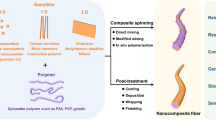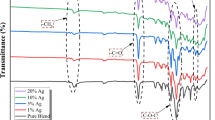Abstract
Copper–fluoropolymer (Cu-CFx) nano-composite films are deposited by dual ion-beam sputtering. The extensive analytical characterization of these layers reveals that inorganic nanoparticles composed of Cu(II) species are evenly dispersed in a branched fluoropolymer matrix. In particular, X-ray photoelectron spectroscopy has been employed to study the surface chemical composition of the material and to assess how it changes on increasing the copper loading in the composite. Transmission electron microscopy reveals that the copper nanoclusters have a mean diameter of 2–3 nm and are homogeneously in-plane distributed in the composite films. Electrothermal atomic absorption spectroscopy has been used to study the kinetics of copper release in the solutions employed for the biological tests. The Cu-CFx layers are employed as bioactive coatings capable of inhibiting the growth of target microorganisms such as Saccharomyces cerevisiae, Escherichia coli, Staphylococcus aureus, and Lysteria. The results of the analytical characterization enable a strict correlation to be established among the chemical composition of the material surface, the concentration of copper dissolved in the microorganisms broths, and the bioactivity of the nano-structured layer.






Similar content being viewed by others
References
Cioffi N, Losito I, Torsi L, Farella I, Valentini A, Sabbatini L, Zambonin PG, Bleve-Zacheo T (2002) Chem Mater 14:804–811
Cioffi N, Torsi L, Farella I, Altamura D, Valentini A, Ditaranto N, Sabbatini L, Zambonin PG, Bleve-Zacheo T (2004) Thin Solid Films 449:25–33
Farella I, Valentini A, Cioffi N, Torsi L (2004) Appl Phys A, (in press)
Convertino A, Valentini A, Bassi A, Cioffi N, Torsi L, Cirillo ENM (2002) Appl Phys Lett 80:1565–1567
Cioffi N, Farella I, Torsi L, Valentini A, Sabbatini L, Zambonin PG (2003) Sensors Actuators B Chem B93:181–186
Wu PK (1995) Mater Res Soc Symp Proc 385:79–90 and references therein cited
Dalacu D, Brown AP, Klemberg-Sapieha JE, Martinu L, Wertheimer MR, Najafi SI, Andrews MA (1999) Mater Res Soc Symp Proc 544:167–172
Goto A (1998) Jpn Kokai Tokkyo Koho, p 7, patent
Gritsenko KP (1998) Proc SPIE Int Soc Opt Eng 3347:165–173
Ueda Y, Yashiro T (1992) Jpn Kokai Tokkyo Koho, p 3, patent
McLaughlin JA, Macken D, Meenan BJ, McAdams ET, Maguire PD (1995) Key Eng Mater 99:331–338
Cioffi N, Torsi L, Farella I, Altamura D, Valentini A, Quinto M, Sabbatini L, Zambonin PG (2004) Sensors Actuators B Chem B100:9–16
Rotunno S (2002) Analisi dello swelling indotto da vapori di solventi organici in film di nanocompositi Teflon-like (Cu). Graduate thesis in physics, University of Bari
Cioffi N, Torsi L, Ditaranto N, Tantillo G, Ghibelli L, Sabbatini L, Bleve-Zacheo T, D’Alessio M, Zambonin PG, Traversa E (in press)
Quaranta F, Valentini A, Rizzi FR, Casamassima G (1993) J Appl Phys 74:244–248
Pertsin AI, Pashunin YM (1996) Vysokomol Soedin Ser A Ser B 38:919–923
NIST XPS Database
Weast RC (ed)(1976) Handbook of chemistry and physics, 57th edn. CRC Press Inc., Ohio
Toy MS (1971) J Polym Sci Polym Symp 34:273–279
Acknowledgments
Miss C. Caso, Mr S. Giacummo, and Mr A. Tambone are gratefully thanked for their skilled assistance during biological experiments (C.C.) and XPS analyses (S.G., A.T.). Professor E. Traversa and Dr L. Ghibelli are greatly acknowledged for useful discussions.
Author information
Authors and Affiliations
Corresponding author
Appendix
Appendix
Curve-fit parameters employed for XPS data treatment
Full width at half maximum values (eV) as a function of spectral region and metal loading
φ | C1s | F1s | O1s | Cu2p3/2a | ||
|---|---|---|---|---|---|---|
Photoelectron peaks (1 and 2) | Shake-up (1) | Shake-up (2 and 3) | ||||
0.05 | 2.29 | 2.66 | – | – | – | – |
0.15 | 2.34 | 2.82 | 2.40 | 3.64 | 3.18 | 3.12 |
0.25 | 2.13 | 2.71 | 2.40 | 3.82 | 3.82 | 2.90 |
The curve-fit function (gl) takes into account the mixed Gaussian–Lorentzian character of the peak shape as reported in the following:
The tail function is:
and the total function is:
where x is an energy variable, h the peak height, m the Lorentzian/Gaussian merge factor as Lorentzian percentage center (peak center), b the peak width, CT the tail constant, ETH the exponential tail height, and ET the exponential tail.
Generally speaking, curve-fitting was carried out without the use of tails (CT=0, EHT=0, ET=0), except for the cupric oxide component of the Cu2p3/2 and O1s spectral regions. For these signals, after analysis of a CuO standard, the parameters reported in the table were used.
Tail parameters used for curve-fitting in the O1s and Cu2p3/2 regions
| CT | EHT | ET |
|---|---|---|---|
CuO | 0.01 | 0.0384 | 0.2 |
CuO | 0.005 | 0.05 | 0.05 |
Rights and permissions
About this article
Cite this article
Cioffi, N., Ditaranto, N., Torsi, L. et al. Analytical characterization of bioactive fluoropolymer ultra-thin coatings modified by copper nanoparticles. Anal Bioanal Chem 381, 607–616 (2005). https://doi.org/10.1007/s00216-004-2761-4
Received:
Revised:
Accepted:
Published:
Issue Date:
DOI: https://doi.org/10.1007/s00216-004-2761-4




